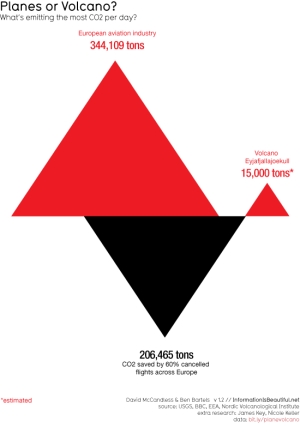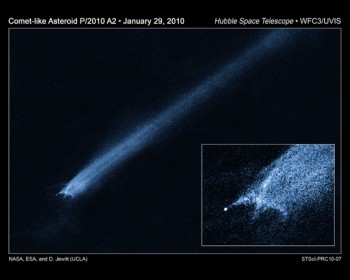The eclipse season continues, as the Moon's nodes--the intersection line of the Moon's orbital plane and the Earth's orbital plane--continue to point in the direction of the Sun and anti-Sun. After the winter solstice lunar eclipse Europe, Northern Africa, and the Middle East will get a partial solar eclipse on January 4th. The maximum eclipse reaches nearly 86% in Scandinavia, although I wouldn't really trust a low-altitude solar eclipse at the Arctic Circle this time of year to be likely visible.
Since we know the Moon's orbital plane right now, we can extrapolate to the appearance of the Moon in upcoming months and phases. We know that the first and third quarter Moons will be either higher or lower away from the ecliptic, since at new the moon was obviously at the ecliptic (to produce the eclipse). So we need one other piece of information to give us the appearance of the Moon in the sky: is the node ascending or descending? Recall the Moon passing Jupiter about two weeks ago.
Was it above or below Jupiter in the sky?
Sadly, I had to check via a planetarium program because I couldn't remember. It passed above Jupiter. So the node is ascending, and the First Quarter Moon in January will be higher than usual in the sky and the Third Quarter Moon lower (but keep in mind only in deviation from the ecliptic, not in absolute elevation in the sky). In three months (aka March-April) the full Moon will be lower in the sky than usual and rise and set further south than normal.
http://eclipse.gsfc.nasa.gov/OH/OH2011.html
Sunday, December 26, 2010
Wednesday, December 15, 2010
Light Pollution also boosts air pollution
In addition to causing breast cancer, light pollution has now been shown to affect the atmospheric chemistry at night in urban regions, increasing the next day air pollution by up to 5%. Ignoring any deleterious effect on astronomy, why are we being idiots on this? Why can't people aim lights correctly so they don't miss well over 50% of the thing they want to light? Why can't we understand if you want to light something on the ground, you can't do it by sending light up?
http://www.bbc.co.uk/news/science-environment-11990737
http://www.treehugger.com/files/2010/12/urban-light-pollution-boosts-air-pollution.php
http://www.bbc.co.uk/news/science-environment-11990737
http://www.treehugger.com/files/2010/12/urban-light-pollution-boosts-air-pollution.php
Monday, November 08, 2010
Pluto is bigger than Eris
A rare occultation of a star by the Kuiper Belt Object known as Eris was recorded in several stations in Chile and at first glance the data suggest Eris is in fact smaller than Pluto--the albedo of Eris must be higher than predicted.
Sky & Telescope has a good write-up.
Here's a report from one of the observers.
And here's Mike Brown's take on the observation (An observation of the observation).
Sky & Telescope has a good write-up.
Here's a report from one of the observers.
And here's Mike Brown's take on the observation (An observation of the observation).
Thursday, November 04, 2010
Comet Hartley 2 close-up by EPOXI
Oh man, this is great. The radar images from last week indicated the comet was dog-boned shaped but the close-ups from the former Deep Impact/now EPOXI mission are great and confirmed the nature of this heterogeneous object. In other words, this looks just like some of the asteroids out there.

Credit: NASA / JPL / UMD / Emily Lakdawalla
Click to enlarge

Credit: NASA / JPL / UMD / Emily Lakdawalla
Click to enlarge
Wednesday, October 20, 2010
The star next to the moon tonight
The bright "star" next to the nearly Full Moon tonight was Jupiter, in case you were wondering.
Saturday, October 16, 2010
stupid UFO sightings
Hi. I've spent much of my life outside at night looking up. I've seen some amazing things. I've never seen a UFO. I've seen things that would have easily been confused as an unknown object, until I figured or observed what exactly it was. Things like inbound aircraft to O'Hare, geese lit up by stupid uplights in Chicago, spectacular bolide fireballs, reflections off of Iridium satellites, etc. The general public doesn't really look up very often, and hence doesn't really know what they are seeing. So Venus, or Jupiter, or a series of balloons become a UFO, which despite the name become a ... UFO.
http://blogs.discovermagazine.com/badastronomy/2010/10/15/nyc-fox-station-reports-jupiter-and-balloons-as-ufos/?utm_source=feedburner&utm_medium=feed&utm_campaign=Feed%3A+BadAstronomyBlog+%28Bad+Astronomy%29&utm_content=Google+Reader
http://blogs.discovermagazine.com/badastronomy/2010/10/15/nyc-fox-station-reports-jupiter-and-balloons-as-ufos/?utm_source=feedburner&utm_medium=feed&utm_campaign=Feed%3A+BadAstronomyBlog+%28Bad+Astronomy%29&utm_content=Google+Reader
Friday, October 01, 2010
small earthquake swarm just north of Death Valley and Scotty's Castle
This in an interesting swarm of earthquakes just to the north of Scotty's Castle in Death Valley.
http://earthquake.usgs.gov/earthquakes/recenteqscanv/FaultMaps/117-37.html
http://earthquake.usgs.gov/earthquakes/recenteqscanv/FaultMaps/117-37.html
Thursday, September 30, 2010
The Magic numbers
"The magic numbers, as we know them now are :
2, 8, 20, 28, 50, 82, 126
and most importantly, they are the same for neutrons and protons."
Maria Goeppert-Mayer, The Nobel Lecture
The last female Nobel Laureate in Physics, 1963.
2, 8, 20, 28, 50, 82, 126
and most importantly, they are the same for neutrons and protons."
Maria Goeppert-Mayer, The Nobel Lecture
The last female Nobel Laureate in Physics, 1963.
Monday, September 20, 2010
fluorescent light runs at 25kHz
The newish fluorescent light (well, added in 1999 to make up for a lost skylight) fixture in the RAS office must have an electronic ballast that runs at 25kHz, as that is a strong signal that pops up on the oscilloscope & antenna when that light circuit is running. The older fluorescent lights are probably ancient magnetic ballasts.
...I'm sure y'all care.
...I'm sure y'all care.
Wednesday, September 15, 2010
Pits on the Moon

Phil Plait points out pits on the Moon!


Click to enlarge. Images via NASA/GSFC/Arizona State University/LROC
Thursday, September 09, 2010
Notable: the size of the standard AC outlet
Did you know the distance between the center of the slots in the 120V standard AC outlet is exactly 1/2 inch? And so is the distance between the center of those and the center of the ground pin. 0.5". All of this only came out after I bought an inexpensive digital caliper and started measuring everything I could get my hands on.
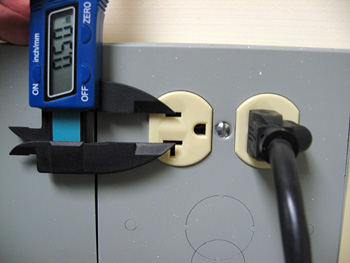
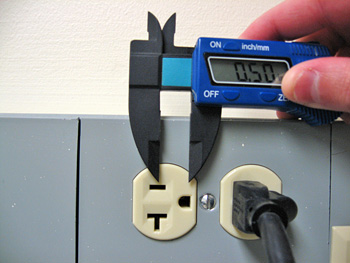


Tuesday, September 07, 2010
Today's sunny and windy weather
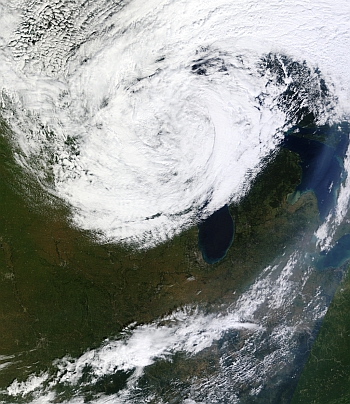
Click to enlarge to medium size. The link below goes to the really big image.
Today's weather in Chicago as seen from above via the MODIS imager on the Terra satellite. It was sunny and very windy with winds out of the southwest. It looks like you can see some dust streamers coming out off the lakeshore. Click on the link below for the huge 5200x6000 image with 250m resolution.
http://ge.ssec.wisc.edu/modis-today/index.php?satellite=t1&product=true_color&date=2010_09_07_250&overlay_sector=false&overlay_state=false&overlay_coastline=true§or=USA3&resolution=250m
Credits: http://ge.ssec.wisc.edu/modis-today/credits.html
Thursday, September 02, 2010
"The SDSS and e-science archiving at the University of Chicago Library"
The SDSS and e-science archiving at the University of Chicago Library
Barbara Kern, University of Chicago
Dean Armstrong, University of Chicago
Charles Blair, University of Chicago
David Farley, University of Chicago
Kathleen Feeney, University of Chicago
Eileen Ielmini, University of Chicago
Elisabeth Long, University of Chicago
Daniel Meyer, University of Chicago
Peggy Wilkins, University of Chicago
The Sloan Digital Sky Survey (SDSS) is a co-operative scientific project involving over 25 institutions worldwide and managed by the Astrophysical Research Consortium (ARC) to map one- quarter of the entire sky in detail, determining the positions and absolute brightness of hundreds of millions of celestial objects. The project was completed in October 2008 and produced over 100 terabytes of data comprised of object catalogs, images, and spectra. While the project remained active, SDSS data was housed at Fermilab. As the project neared completion the SDSS project director (and University of Chicago faculty member) Richard Kron considered options for long term storage and preservation of the data turning to the University of Chicago Library for assistance. In 2007-2008 the University of Chicago Library undertook a pilot project to investigate the feasibility of long term storage and archiving of the project data and providing ongoing access by scientists and educators to the data through the SkyServer user interface. In late 2008 the University of Chicago Library entered into a formal agreement with ARC agreeing to assume responsibility for:
• Archiving of the survey data (long-term scientific data archiving)
• Serving up survey data to the public
• Managing the HelpDesk
• Preserving the SDSS Administrative Record
This paper outlines the various aspects of the project as well as implementation.
Barbara Kern, University of Chicago
Dean Armstrong, University of Chicago
Charles Blair, University of Chicago
David Farley, University of Chicago
Kathleen Feeney, University of Chicago
Eileen Ielmini, University of Chicago
Elisabeth Long, University of Chicago
Daniel Meyer, University of Chicago
Peggy Wilkins, University of Chicago
The Sloan Digital Sky Survey (SDSS) is a co-operative scientific project involving over 25 institutions worldwide and managed by the Astrophysical Research Consortium (ARC) to map one- quarter of the entire sky in detail, determining the positions and absolute brightness of hundreds of millions of celestial objects. The project was completed in October 2008 and produced over 100 terabytes of data comprised of object catalogs, images, and spectra. While the project remained active, SDSS data was housed at Fermilab. As the project neared completion the SDSS project director (and University of Chicago faculty member) Richard Kron considered options for long term storage and preservation of the data turning to the University of Chicago Library for assistance. In 2007-2008 the University of Chicago Library undertook a pilot project to investigate the feasibility of long term storage and archiving of the project data and providing ongoing access by scientists and educators to the data through the SkyServer user interface. In late 2008 the University of Chicago Library entered into a formal agreement with ARC agreeing to assume responsibility for:
• Archiving of the survey data (long-term scientific data archiving)
• Serving up survey data to the public
• Managing the HelpDesk
• Preserving the SDSS Administrative Record
This paper outlines the various aspects of the project as well as implementation.
Thursday, August 26, 2010
Tuesday, August 24, 2010
2009 US Energy use
https://publicaffairs.llnl.gov/news/news_releases/2010/images/energy-flow-annotated.pdf
The latest energy generation/use chart for the US is out. Sinks and source, plus general field of use--it's a fascinating chart, and I hope it gives you a sense of where real solutions to the energy issue lie. Let's work on the efficiency issue.
Via Treehugger
The latest energy generation/use chart for the US is out. Sinks and source, plus general field of use--it's a fascinating chart, and I hope it gives you a sense of where real solutions to the energy issue lie. Let's work on the efficiency issue.
Via Treehugger
Sunday, August 22, 2010
Another impact on Jupiter
http://www.skyandtelescope.com/observing/home/101264994.html
My first thought once it was confirmed was "What is the real rate of visible Jovian impacts versus our sampling rate of looking for them?".
My first thought once it was confirmed was "What is the real rate of visible Jovian impacts versus our sampling rate of looking for them?".
Wednesday, August 04, 2010
Haze and smoke from western Canada
Haze and smoke visible in on the visible satellite image for this afternoon might give the less humid weather the next few days in Chicago a tinge of non-clarity.
http://www.osdpd.noaa.gov/ml/land/hms.html
http://www.osdpd.noaa.gov/ml/land/hms.html
Monday, July 12, 2010
Saturn visible behind Lutetia during flyby
Hey, this is pretty cool; I'm always a fan of planetary conjunctions.
Saturn was visible in a few of the images of Lutetia taken by Rosetta as it passed by!
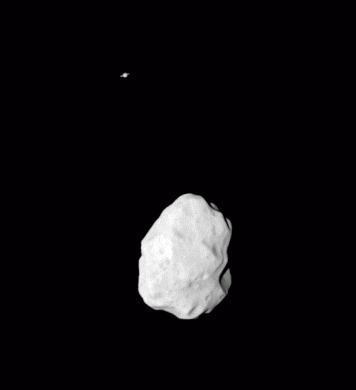
Saturn was visible in a few of the images of Lutetia taken by Rosetta as it passed by!

Saturday, July 10, 2010
Fly-by of Lutetia is a success
Another successful asteroid fly-by!
http://www.planetary.org/blog/article/00002577/
http://www.planetary.org/blog/article/00002577/
Wednesday, July 07, 2010
Old Mars photos from 2003: No, it's not going to be big in August.
Inspired by a query regarding the false meme going around about Mars, I took a look at some images I took of Mars during it's big opposition in 2003. That was a great opposition. Here's a couple of those images. The first one is a single image without manipulation, the second and third are Registax processed images from videos, and the last is one of those videos.
Mars at the moment is not approaching one of those awesome 17 year oppositions like 2003 or 1988. It's just fading away from its January opposition and currently visible in Leo in the evening.
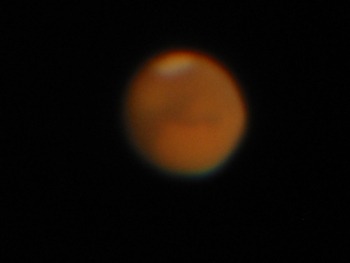
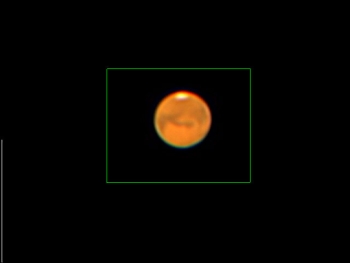

Mars at the moment is not approaching one of those awesome 17 year oppositions like 2003 or 1988. It's just fading away from its January opposition and currently visible in Leo in the evening.



Wednesday, June 23, 2010
nose grease
In my high school days I had a part-time job at a professional photo lab / studio called "Phillips' Photo Lab". I was hired as the black and white darkroom guy--I manually processed film, printed custom prints, shot copy negatives, and cleaned the color film and print processors. Later I branched into running the shop on Saturdays and once, just once, did a color print job.
I learned a lot from the pros whose lifeblood was photography: the tips and techniques that make life easier.
One of the things that I would not had believed unless I had personally experienced it was the magic of nose grease. The skin on the nose and to a lesser extent the neck near the back of the ears produces a hydrocarbon of about C30H50 called squalene. The only reason this is important was squalene had the same index of refraction as the gelatin used in photographic processes and hence could be used to fill in scratches on negatives and slides. You would acquire some nose grease, rub it gently into the scratch, and rewash the negative. Nearly as good as new, and it allowed prints and reproductions from otherwise damaged negatives.
This particular example is this blog's first mention of a principle I like to call "matching impedances". In the world there are a lot of interesting issues that in the end are solved or mitigated by taking two different systems and making them the same at the point they meet. In electronics, to maximize power transfer between two parts of a circuit, you match their electrical impedances (which is a function of their resistance at all frequencies).
You have encountered this when setting up a TV or stereo system; the speakers have an impedance rating on them, usually 8ohms for a home stereo and 4 for car audio. Your amplifier speaker outputs need to be designed to deal with a particular impedance; stick a 4ohm speaker on an amp designed for 8 and you might mess things up. On your TVs there used to be two terminals for antennas--one was coaxial and had an impedance of 75ohms and is now the de facto standard, and the other was two screws that had an impedance of 300ohms. To get the most signal you'd want all the impedances to match up: the TV, the cable, and the antenna. If they didn't, part of the precious signal would be reflected back towards the antenna and lost. For converting the impedances to match a little transformer was used, of which there may be a hundred million hiding behind the TVs of the world. Again, here the principle of matching the impedances came into play.
In the optical world reflections occur at surfaces that have differing indexes of refraction. The bigger the difference the higher the reflection ( I think it's a square of (n-n2/n+n2). For solar panels, for instance, the high index of refraction of silicon (4) compared to air (1) makes something like 50% of the incident light reflect off unless you use anti-reflective coatings to improve it. So even for something like a renewable energy resource you have to consider such details.
I use nose grease (n=1.45) to also try to fill in scratches in CDs/DVDs (made of polycarbonate, n=1.58). It's not perfect, but sometimes it makes it playable.
So, in the end: Match your impedances!
I learned a lot from the pros whose lifeblood was photography: the tips and techniques that make life easier.
One of the things that I would not had believed unless I had personally experienced it was the magic of nose grease. The skin on the nose and to a lesser extent the neck near the back of the ears produces a hydrocarbon of about C30H50 called squalene. The only reason this is important was squalene had the same index of refraction as the gelatin used in photographic processes and hence could be used to fill in scratches on negatives and slides. You would acquire some nose grease, rub it gently into the scratch, and rewash the negative. Nearly as good as new, and it allowed prints and reproductions from otherwise damaged negatives.
This particular example is this blog's first mention of a principle I like to call "matching impedances". In the world there are a lot of interesting issues that in the end are solved or mitigated by taking two different systems and making them the same at the point they meet. In electronics, to maximize power transfer between two parts of a circuit, you match their electrical impedances (which is a function of their resistance at all frequencies).
You have encountered this when setting up a TV or stereo system; the speakers have an impedance rating on them, usually 8ohms for a home stereo and 4 for car audio. Your amplifier speaker outputs need to be designed to deal with a particular impedance; stick a 4ohm speaker on an amp designed for 8 and you might mess things up. On your TVs there used to be two terminals for antennas--one was coaxial and had an impedance of 75ohms and is now the de facto standard, and the other was two screws that had an impedance of 300ohms. To get the most signal you'd want all the impedances to match up: the TV, the cable, and the antenna. If they didn't, part of the precious signal would be reflected back towards the antenna and lost. For converting the impedances to match a little transformer was used, of which there may be a hundred million hiding behind the TVs of the world. Again, here the principle of matching the impedances came into play.
In the optical world reflections occur at surfaces that have differing indexes of refraction. The bigger the difference the higher the reflection ( I think it's a square of (n-n2/n+n2). For solar panels, for instance, the high index of refraction of silicon (4) compared to air (1) makes something like 50% of the incident light reflect off unless you use anti-reflective coatings to improve it. So even for something like a renewable energy resource you have to consider such details.
I use nose grease (n=1.45) to also try to fill in scratches in CDs/DVDs (made of polycarbonate, n=1.58). It's not perfect, but sometimes it makes it playable.
So, in the end: Match your impedances!
Wednesday, June 09, 2010
Hayabusa coming home
An amazing comeback for the little falcon that could--

Credit: ISAS / JAXA / Øyvind Guldbrandsen / Planetary Society Blog
The Japanese spacecraft Hayabusa will be returning to Earth with perhaps a sample of the asteroid Itokawa in just four days. This spacecraft has had as many setbacks in the seven years it's been running as you can have without losing the craft completely. When they released the data archive in 2007 I made a color image of Earth made by Hayabusa during a flyby and some more surface close-ups here.

Credit: ISAS / JAXA / Øyvind Guldbrandsen / Planetary Society Blog
The Japanese spacecraft Hayabusa will be returning to Earth with perhaps a sample of the asteroid Itokawa in just four days. This spacecraft has had as many setbacks in the seven years it's been running as you can have without losing the craft completely. When they released the data archive in 2007 I made a color image of Earth made by Hayabusa during a flyby and some more surface close-ups here.
Friday, June 04, 2010
Friday, May 21, 2010
Eyjafjallajökull eruption: webcam at midnight
It's midnight in Iceland and nearly midsummer with a volcano erupting, what do you do? Hang out in front of the thermal camera.
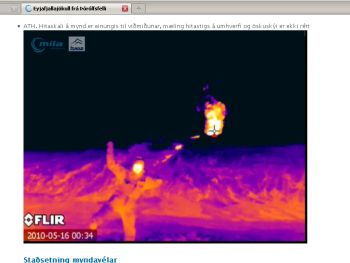

Wednesday, May 12, 2010
Eyjafjallajökull eruption: webcams
There are several webcams watching the Ejyafjallajökull eruption; and at this time of year the plume is illuminated all the short night long. I watched the sunset at 10:30PM and am now watching the sun rise at 4:30AM. The eruption continues through the Arctic summer night.
http://eldgos.mila.is/english/eyjafjallajokull-fra-hvolsvelli/
http://eldgos.mila.is/english/eyjafjallajokull-fra-thorolfsfelli/
This one is closer and has a thermal IR camera as well; but it's also more often obscured by ash and fog.
http://eldgos.mila.is/english/eyjafjallajokull-fra-hvolsvelli/
http://eldgos.mila.is/english/eyjafjallajokull-fra-thorolfsfelli/
This one is closer and has a thermal IR camera as well; but it's also more often obscured by ash and fog.
Tuesday, May 11, 2010
Jupiter's SEB has gone pale
Jupiter's South Equatorial Belt, normally a brown-red, has gone as pale as the cream white zones surrounding it. Check out the report with images at the Planetary Society Blog: http://networkedblogs.com/3Jnoh. This is one of those things that happens every 5-10 years or so.
Thursday, April 29, 2010
Sunday, April 25, 2010
Friday, April 23, 2010
The view from Thorvaldseyri of the Eyjafjallajökull eruption
The view from Thorvaldseyri of Eyjafjallajökull

You can just pick out the ice sheet from underneath the clouds.
Compare this with the view the farmer had recently:
http://icelandreview.com/icelandreview/upload/images/news/almennt/thorvaldseyri_olafur_eggertsson.jpg
From:
http://icelandreview.com/icelandreview/daily_news/?cat_id=16539&ew_0_a_id=361234

You can just pick out the ice sheet from underneath the clouds.
Compare this with the view the farmer had recently:
http://icelandreview.com/icelandreview/upload/images/news/almennt/thorvaldseyri_olafur_eggertsson.jpg
From:
http://icelandreview.com/icelandreview/daily_news/?cat_id=16539&ew_0_a_id=361234
Sunday, April 18, 2010
Eyjafjallajökull eruption: gorgeous video
The NY Times Lede blog has linked to BBC Channel 4 video of the eruption. From the look of it, the videographer had one of the many excursion drivers take them up Thórsmörk (or Þórsmörk) valley on the north side up high enough to look at the eruption without dealing with the jokulhaup (or glacial flood) in the river. If you have ADD you will miss the active sub-Plinian eruption and great lightning in latter half of the video.
UPDATE: the waterfall at the beginning is Seljalandsfoss. I have a photo of it here: http://www.flickr.com/photos/dwarmstr/4532063271/.
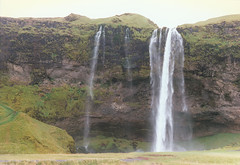
EDIT: calling it sub-Plinian.
UPDATE: the waterfall at the beginning is Seljalandsfoss. I have a photo of it here: http://www.flickr.com/photos/dwarmstr/4532063271/.

EDIT: calling it sub-Plinian.
Eyjafjallajökull eruption: planes vs. volcano
Saturday, April 17, 2010
Moments in spaceflight
Soichi Noguchi captures a poignant moment as the Shuttle leaves the International Space Station. Click to enlarge to a higher quality image.


Thursday, April 15, 2010
Eyjafjallajökull eruption
I was just reading about the Eyjafjallajökull eruption yesterday and the rather bold tourist enterprise sprung up to visit it, when I see it has erupted in an explosive manner. The new path to the surface for the magma opened under the ice sheet (jokull) instead of bare ground, and water/magma interactions produce copious amounts of gas. Gas is a bad thing when it comes to magma. It makes thing go boom. Instead of a lava fountain and a tourist stop in Iceland, now we have flooding as the glacier melts, and air travel restrictions as the volcano generates large plumes up into the atmosphere from the phreatic eruption. The Icelanders are concerned about the flooding and the fluorine from the ashfall. For the geology, the composition of the magma (how much silica is in it, how much gas is in it), its interaction with the surrounding rock, and how the magma changes in composition as time increases are the interesting things. For the British sitting waiting for the air to clear, realize that ash is just magma pulverized through explosive means. Blame the gas.
Here is some good information on the location and the inflation/deflation data.
Here is some good information on the location and the inflation/deflation data.
Thursday, April 01, 2010
Geiger counter problems interfacing with PC
I've been unable to get the DOS software AW-SRAD to work with the geiger counter for some time, on multiple machines, with Windows XP. It's a bummer. I can input the sound pulses from the clicker unit I made into a sound card, but I have no idea how to then get the PC to do something with that. I'm not a programmer. The original geiger counter set up was really simple: it toggled the RING indicator on the serial port.
Tuesday, March 30, 2010
For Photographers, the Image of a Shrinking Path
For Photographers, the Image of a Shrinking Path
By STEPHANIE CLIFFORD
Published: March 29, 2010
Amateur photographers, happy to accept small checks for snapshots, are underpricing professionals.
I made some comments about this issue last year in this post: http://dwarmstr.blogspot.com/2009/06/intersection-of-onlinesharing-culture.html. Since then, I made that Faustian bargain of getting an image of mine on a book cover without payment save a few copies of the book (although I haven't gotten them yet, CRC Press). The publisher said they had no budget for images, it would likely sell very few copies (a very technical book), etc... should I have done it?
Conversely, if you are a corporation, why shouldn't you find free or cheap photography instead of paying for it? Photography has been freelance for sometime, and never unionized that I am aware of.
By STEPHANIE CLIFFORD
Published: March 29, 2010
Amateur photographers, happy to accept small checks for snapshots, are underpricing professionals.
I made some comments about this issue last year in this post: http://dwarmstr.blogspot.com/2009/06/intersection-of-onlinesharing-culture.html. Since then, I made that Faustian bargain of getting an image of mine on a book cover without payment save a few copies of the book (although I haven't gotten them yet, CRC Press). The publisher said they had no budget for images, it would likely sell very few copies (a very technical book), etc... should I have done it?
Conversely, if you are a corporation, why shouldn't you find free or cheap photography instead of paying for it? Photography has been freelance for sometime, and never unionized that I am aware of.
Thursday, March 25, 2010
Thursday, March 04, 2010
Evening ISS passes for the next few days in Chicago
http://www.heavens-above.com/PassSummary.aspx?satid=25544&lat=41.781312&lng=-87.605097&loc=Chicago&alt=0&tz=CST
4 Mar -2.4 19:27:17 10 WSW 19:30:00 44 NW 19:30:00 44 NW
5 Mar -3.3 18:17:05 10 SW 18:19:55 60 SE 18:22:47 10 ENE
6 Mar -2.2 18:42:14 10 WSW 18:45:00 41 NNW 18:47:31 12 NE
7 Mar -1.0 19:08:01 10 WNW 19:10:16 20 NNW 19:11:50 14 NNE
8 Mar -2.1 17:57:05 10 W 17:59:50 39 NNW 18:02:35 10 NE
It might actually be clear!
4 Mar -2.4 19:27:17 10 WSW 19:30:00 44 NW 19:30:00 44 NW
5 Mar -3.3 18:17:05 10 SW 18:19:55 60 SE 18:22:47 10 ENE
6 Mar -2.2 18:42:14 10 WSW 18:45:00 41 NNW 18:47:31 12 NE
7 Mar -1.0 19:08:01 10 WNW 19:10:16 20 NNW 19:11:50 14 NNE
8 Mar -2.1 17:57:05 10 W 17:59:50 39 NNW 18:02:35 10 NE
It might actually be clear!
Thursday, February 25, 2010
Live video feed from the International Space Station
This is great; I've been holding off on sharing this because I felt like it was too special to share widely. But here's the deal--there is a live video feed on the International Space Station. And usually it's pointing out at Earth. So literally you can watch the Earth go by live. You can experience sunrise and sunset in orbit. You can see the biggest cities' light pollution on the dark part of the orbit and sun glints of the Pacific or the swirls in the clouds in the Southern Ocean.
Here's the Live ISS video feed. If you stop the video, reload the page rather than restarting the video; otherwise regular NASA TV will start up.
See where the ISS is via http://www.heavens-above.com/orbit.aspx?satid=25544&lat=41.781312&lng=-87.605097&loc=Chicago&alt=0&tz=CST and http://www.n2yo.com
.
There are some parts of the orbit with no video download. It is also sensitive to the TDRSS capacity.
While writing this, I am watching sunrise on the ISS just south of South Africa. It is beautiful.
Here's the Live ISS video feed. If you stop the video, reload the page rather than restarting the video; otherwise regular NASA TV will start up.
See where the ISS is via http://www.heavens-above.com/orbit.aspx?satid=25544&lat=41.781312&lng=-87.605097&loc=Chicago&alt=0&tz=CST and http://www.n2yo.com
.
There are some parts of the orbit with no video download. It is also sensitive to the TDRSS capacity.
While writing this, I am watching sunrise on the ISS just south of South Africa. It is beautiful.
Thursday, February 18, 2010
Can you stand it? Cloud footage running backwards
I'm going to be honest:
I can't stand anyone running cloud video footage in reverse. This drives me crazy; whether it's my physics and chemistry of the atmosphere classes or just my sensibilities but whenever I see it it drives me crazy (c.f. Survivor this season). If the cloud droplets are evaporating or condensing the wrong way, anyone with meteorological experience (or someone who has watched Koyaanisqatsi) will call shenanigans. Convection has a distinct look to it; as well as evaporation; and when producers try to reverse the video it shows.
h
I can't stand anyone running cloud video footage in reverse. This drives me crazy; whether it's my physics and chemistry of the atmosphere classes or just my sensibilities but whenever I see it it drives me crazy (c.f. Survivor this season). If the cloud droplets are evaporating or condensing the wrong way, anyone with meteorological experience (or someone who has watched Koyaanisqatsi) will call shenanigans. Convection has a distinct look to it; as well as evaporation; and when producers try to reverse the video it shows.
h
Monday, February 15, 2010
Re: Video of the day, rocket destroys sun dog
Regarding that SDO video, a friend points out another video of the same event:
http://www.spasmsofaccommodation.com/2010/02/sonic-boom-meets-sun-dog.html
http://www.spasmsofaccommodation.com/2010/02/sonic-boom-meets-sun-dog.html
Thursday, February 11, 2010
Video of the day: rocket destroys a sun dog
Sun Dogs are bright refractions of the Sun coming from horizontal ice crystals in the atmosphere. The ice crystals are usually oriented horizontally because that it their stable falling pattern. Watch as the rocket carrying the Solar Dynamic Observatory pierces through a cirrus cloud and the sound waves from the rocket completely obliterate the preferred ice crystal orientation.
http://www.spaceweather.com/swpod2010/11feb10/anna-herbst1.mov?PHPSESSID=ndlp741nbtasb6f51eloa6dp81
http://www.spaceweather.com/swpod2010/11feb10/anna-herbst1.mov?PHPSESSID=ndlp741nbtasb6f51eloa6dp81
Tuesday, February 02, 2010
An asteroid collision
Thursday, January 28, 2010
The orange object next to the full moon tonight
The bright orange "star" next to the Full Moon tonight and Friday is the planet Mars, which happens to be closest to Earth tonight (ok last night) during this current cycle (Mars and Earth come close to each other every 2 years and 2 months). And closest in only the sense of currently: it's still 99 million kilometers away.
Wednesday, January 27, 2010
Joule Thief: a simple DC voltage booster
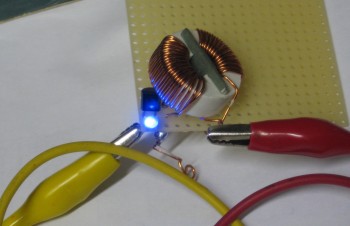
A joule thief circuit lit from a 0.5V AAA battery. Click to enlarge.
A Joule thief is a simple circuit that acts as a DC to DC booster, raising a supply voltage by several volts. In this iteration it uses the exhausted voltage of a alkaline battery and boosts it enough to light a blue LED that requires 2.8V to light. With an otherwise dead 0.5V AAA battery, it will light a blue LED and run for days, using (at the moment) just under 2mA of current. It's much much dimmer than using a fresh battery or running the LED with a proper current through it. Giving the Joule thief circuit 3V from two fresh batteries pulls 75mA through the LED, making it very, very bright and probably short-lived.
A schematic is below. The circuit works like this: When first turned on, current flows into the inductor and produces a magnetic field in the toroid. While this is happening, no voltage appears at the base of the transistor, so the transistor remains off. The LED sees at first no voltage and while the inductor fills up, it only sees a maximum voltage of the battery, which is not enough to pass the diode. Once the inductor is charged, the battery voltage appears at the base of the transistor, turning it on. This allows the right side of the inductor to want to dump the energy it has stored in its magnetic field as quickly as possible, and this gives us a high-voltage that appears across the inductor. When that voltage exceeds 2.8V the LED turns on and lights up until the voltage drops below, triggering the sequence to begin again. I measured the frequency of the on/off oscillation and it seems to run at about 34kHz; the multimeter said between 68 and 72kHz but a radio showed there was 34kHz signal as well, which I assume was the fundamental (and the 68kHz one a harmonic). It did change in frequency a bit while on.
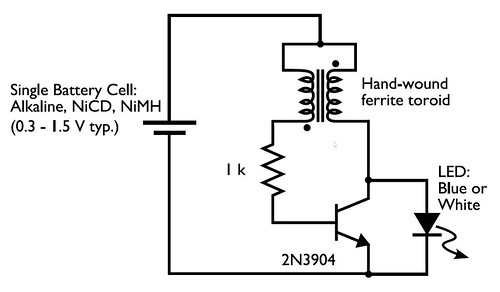 Bre Pettis/Windell Oskay
Bre Pettis/Windell Oskay
Friday, January 22, 2010
Las Vegas precipitation
Las Vegas received more rain last week, 1.69 inches, than it did in all of 2009, when it received 1.59 inches. The "average" is about 4 inches annually. If the rains continue into a full El Nino style winter, the area will bloom green in spring with the normally brown/gray mountains turned into green.
Source: http://www.lvrj.com/news/breaking_news/Rainfall-expected-to-taper-off-today-82379942.html
Source: http://www.lvrj.com/news/breaking_news/Rainfall-expected-to-taper-off-today-82379942.html
Wednesday, January 20, 2010
2010 AL30 animation
Patrick Wiggins makes a cool animation of an object passing by the Earth last week:
http://users.wirelessbeehive.com/~paw/temp/2010AL30.2.GIF
I liked it better than some of the other animations I've seen of the same object, since he didn't center the object on every frame but let it move to the right. This gives the effect of it speeding up.
http://users.wirelessbeehive.com/~paw/temp/2010AL30.2.GIF
I liked it better than some of the other animations I've seen of the same object, since he didn't center the object on every frame but let it move to the right. This gives the effect of it speeding up.
Subscribe to:
Posts (Atom)
